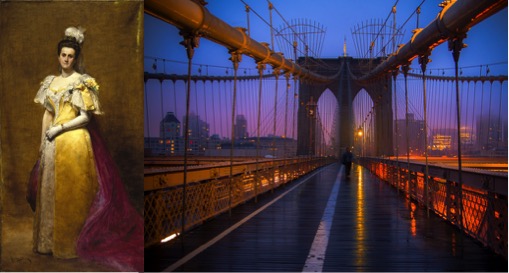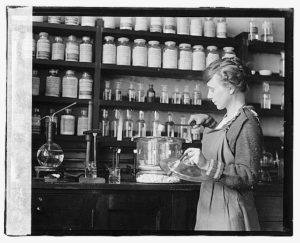She met Queen Victoria, helped to build the Brooklyn Bridge, wrote up last Tsar Nicholas II’s coronation, and lectured a “stunned” roomful of New York lawyers on women’s property rights. Is she on your syllabus, or listed on your museum wall? Meet Emily Warren Roebling (1843-1903), another of the many “hidden figures” who have powered the American fields of science, technology, engineering, and mathematics (STEM). As a Brooklyn native, Roebling’s work looms large in history and memory for me. (If a similar hometown monument sparks your professional imagination, send a proposal by 15 April for our 2017 conference, details here). My blog series pivots next to exploring the dense lives of American women scientists, Puritans to Progressives, who invented, innovated, and laid down the prologue for today’s women in STEM.
Before they won the vote, women made key scientific contributions that shed light on new paths of intellectual and cultural citizenship. This will not be, however, the saga of “my usual heroine.” We’ll move past well-known problem-solvers to see how women struggled to publish, promote, and advance the knowledge they created—smashing apart public/private spheres as they did so. How to buy silk in Charleston, measure pantry needs for a Vermont winter, or factor the pay for New York farm help: these were all early forms of science and math education that girls needed. How did they acquire it? What skills translated into their daily working lives as grown women? How did the professional woman scientist of the 1840s compare with her counterpart of the early 1900s? If we set aside journal articles as the chief evidence of scientific output, then we may get a fuller story. Colonial girls’ copybooks, antebellum ledgers, teenagers’ samplers, and stray math notebooks demonstrate women’s drive for scientific and mathematical literacy at all ages and stages of their lives. As with most history: Hit refresh on the sources, and the story reboots, too.
 Take, for example, the case of American women and the production of cartographic culture. When Thomas Woody presented his landmark History of Women’s Education in the United States in 1929, he pegged a brief but intriguing mention of how women made and used maps. “Geography was the first science for girls, and was almost universally offered until 1840,” Woody wrote, “thereafter it was not offered so regularly in seminaries, but did appear more and more as a preparatory study.” In two volumes that spanned classrooms from Boston to Richmond and ventured into the West, Woody sliced down American women’s involvement in the nation’s thriving cartographic culture to a single, flat line. Why? Early American women regularly drew on cartography as a dual form of cultural expression and professional identity. From the archives, watch as Mehetable Stoddard Sumner, a New England schoolgirl in the spring of 1797, labors over a remarkable trio of geography copybooks. Sumner’s work demonstrates the finer points and painful limits of elite female education in the Enlightenment era. Sumner’s meticulous pen-and-ink renderings include county population statistics, a “doctrine of the sphere” and the “figure of the earth,” a guide to trade winds and monsoons, even a whimsical display of cardinal points. Practicing geography led Sumner and her peers to connect their “reading” and “writing” lives, an act that nurtured a new set of producers, consumers, critics, and audiences for American science.
Take, for example, the case of American women and the production of cartographic culture. When Thomas Woody presented his landmark History of Women’s Education in the United States in 1929, he pegged a brief but intriguing mention of how women made and used maps. “Geography was the first science for girls, and was almost universally offered until 1840,” Woody wrote, “thereafter it was not offered so regularly in seminaries, but did appear more and more as a preparatory study.” In two volumes that spanned classrooms from Boston to Richmond and ventured into the West, Woody sliced down American women’s involvement in the nation’s thriving cartographic culture to a single, flat line. Why? Early American women regularly drew on cartography as a dual form of cultural expression and professional identity. From the archives, watch as Mehetable Stoddard Sumner, a New England schoolgirl in the spring of 1797, labors over a remarkable trio of geography copybooks. Sumner’s work demonstrates the finer points and painful limits of elite female education in the Enlightenment era. Sumner’s meticulous pen-and-ink renderings include county population statistics, a “doctrine of the sphere” and the “figure of the earth,” a guide to trade winds and monsoons, even a whimsical display of cardinal points. Practicing geography led Sumner and her peers to connect their “reading” and “writing” lives, an act that nurtured a new set of producers, consumers, critics, and audiences for American science.
With expertise, came enterprise. Throughout the long nineteenth century, American women flourished as explorers, mapmakers, and frontier guides. Their work is evident in many library shelves’ worth of geographical copybooks, textbooks, atlases, and expeditions. Women mapped frontier land for homesteading, and photographed mountain summits for new scientific societies. They counted and stitched streets into samplers. They printed meticulously detailed vice maps to spur urban reform. Sarah Sophia (S.S.) Cornell, who felt that poor textbooks deterred young scholars, applied a popular corrective with her sprightly, oft-revised works. Geography, Cornell thought, seemed “peculiarly shadowy and evanescent” to students poring over dusty maps—or, as Cornell called them in her best-selling textbook, those “LABYRINTHS OF PERPLEXITY.”
From My Little Geography to Our World, authors Cornell, Harriet Beecher Stowe, Louisa Caroline Tuthill, and Mary L. Hall conquered the lucrative business of geography textbooks. Quite literally, Victorian women remade the world on their own terms, and sold their vision to vast schoolrooms. As women’s mapmaking endeavors grew, professional opportunities slowly blossomed, thereby changing the base structure of the country’s scientific community. This shift yielded a mixed response from the field, catalyzing new career choices for women. Abolitionist Stowe, once she had sketched out racial geopolitics in a textbook that was widely distributed by her sister Catherine
, moved on to writing Uncle Tom’s Cabin. Janice Monk, in her survey of women’s graduate education, wrote that “whether women geographers have valued particular aspects of their work and created distinctive knowledge pose questions of further exploration.”
Let’s reconsider critically, then, the diverse women who coded science and American culture. On or off history’s map, they have worked at a steady rate. Accessing the intellectual issues that these scholars experienced, ca. 17th-20th centuries, might form another history of “lived science.” Here’s a starter bibliography. Your ideas and recommendations for primary and secondary sources are welcome in the comments below. And as for Emily Roebling’s efforts, stay tuned.
Preliminary Bibliography
Abir-Am, Pnina G. and Dorinda Outram, eds. Uneasy Careers and Intimate Lives: Women in Science, 1789-1979. New Brunswick: Rutgers University Press, 1987.
Alic, Margaret. Hypatia’s Heritage: A History of Women in Science from Antiquity through the Nineteenth Century. Boston: Beacon Press, 1986.
Andréolle, Donna Spalding and Véronique Molinari, eds. Women and Science, 17th Century to Present: Pioneers, Activists and Protagonists. Newcastle upon Tyne: Cambridge Scholars, 2001.
Arnold, Lois Barber. Four Lives in Science: Women’s Education in the Nineteenth Century. New York: Schocken Books, 1984.
Baym, Nina. American Women of Letters and the Nineteenth-Century Sciences: Styles of Affiliation. New Brunswick: Rutgers University Press, 2002.
Cohen, Patricia Cline. A Calculating People: The Spread of Numeracy in Early America. Chicago: University of Chicago Press, 1982.
Creese, Mary R.S. Ladies in the Laboratory?: American and British Women in Science, 1800-1900: A Survey of Their Contributions to Research. Lanham: Scarecrow Press, 1998.
Frize, Monique Aubry. The Bold and the Brave: A History of Women in Science and Engineering. Ottawa: University of Ottawa Press, 2009.
Katz, Cindi and Janice Monk, eds. Full Circles: Geographies of Women over the Life Course. London and New York: Routledge, 1993.
Kohlstedt, Sally Gregory, ed. History of Women in the Sciences: Readings from Isis. Chicago: University of Chicago Press, 1999.
Kohlstedt, Sally Gregory and Helen Longino, eds. Women, Gender, and Science: New Directions. Chicago: Osiris, University of Chicago Press, 1997.
Rossiter, Margaret. Women Scientists in America, 2 vols. Baltimore: Johns Hopkins University Press, 19821-1995.
Rossiter, Margaret and Clark Elliott, eds. Science at Harvard, 1636-1945. Bethlehem: Lehigh University Press, 1992.
Rossiter, Margaret and Sally Gregory Kohlstedt, eds. Historical Writing on American Science. Baltimore: Johns Hopkins University Press, 1986.
Schiebinger, Londa. The Mind Has No Sex?: Women in the Origins of Modern Science. Cambridge: Harvard University Press, 1989.
Tolley, Kimberley. The Science Education of American Girls: A Historical Perspective. New York: RoutledgeFalmer, 2003.
Watts, Ruth. Women in Science: A Social and Cultural History. London and New York: Routledge, 2007.



3 Thoughts on this Post
S-USIH Comment Policy
We ask that those who participate in the discussions generated in the Comments section do so with the same decorum as they would in any other academic setting or context. Since the USIH bloggers write under our real names, we would prefer that our commenters also identify themselves by their real name. As our primary goal is to stimulate and engage in fruitful and productive discussion, ad hominem attacks (personal or professional), unnecessary insults, and/or mean-spiritedness have no place in the USIH Blog’s Comments section. Therefore, we reserve the right to remove any comments that contain any of the above and/or are not intended to further the discussion of the topic of the post. We welcome suggestions for corrections to any of our posts. As the official blog of the Society of US Intellectual History, we hope to foster a diverse community of scholars and readers who engage with one another in discussions of US intellectual history, broadly understood.
Women in Engineering: Pioneers and Trailblazers
This is just a hunch, but I feel positive that the Newberry Library’s Hermon Dunlap Center for the History of Cartography (in Chicago, IL) might have something for researchers interested in women and map making. – TL
Thanks, Tim, greatly appreciated. I’ve only visited The Newberry’s excellent collections virtually thus far! Adding it to the list o’ resources to follow up on.